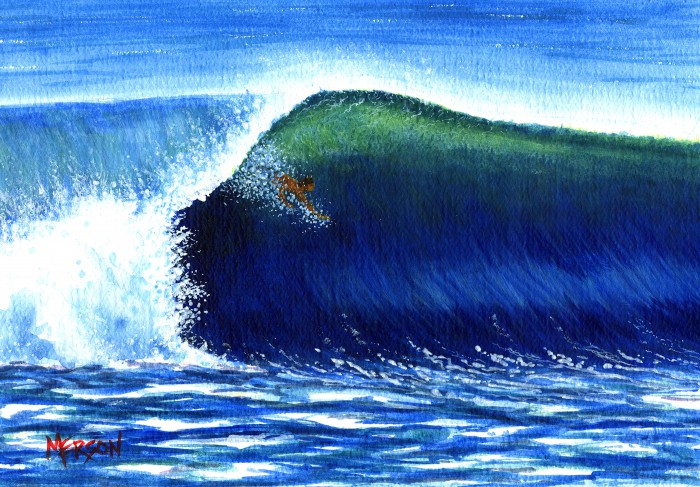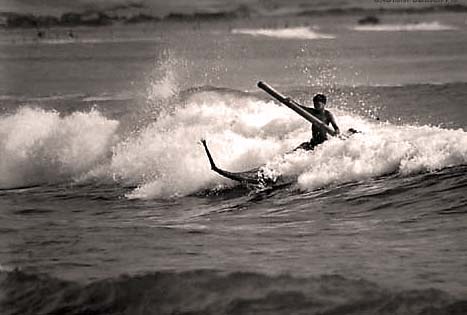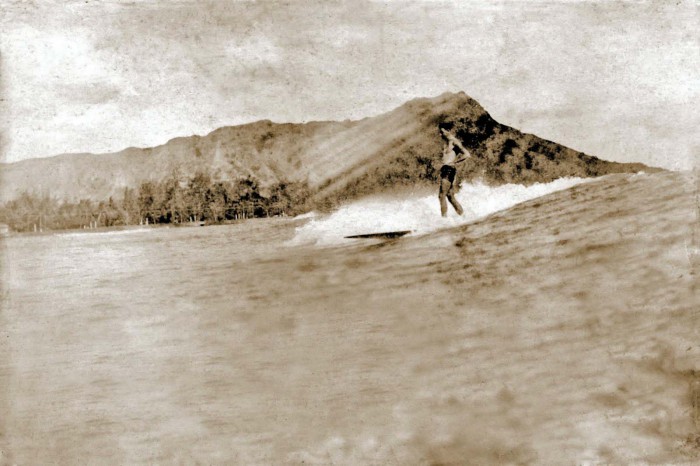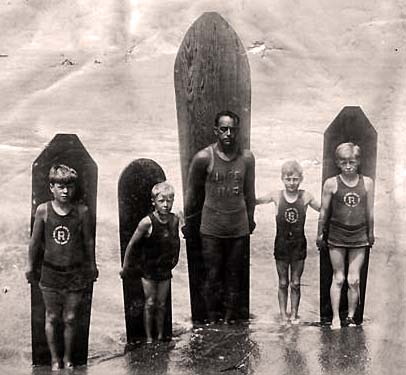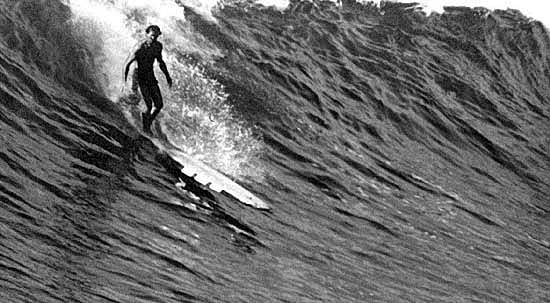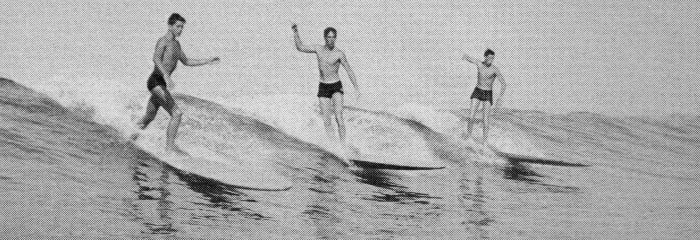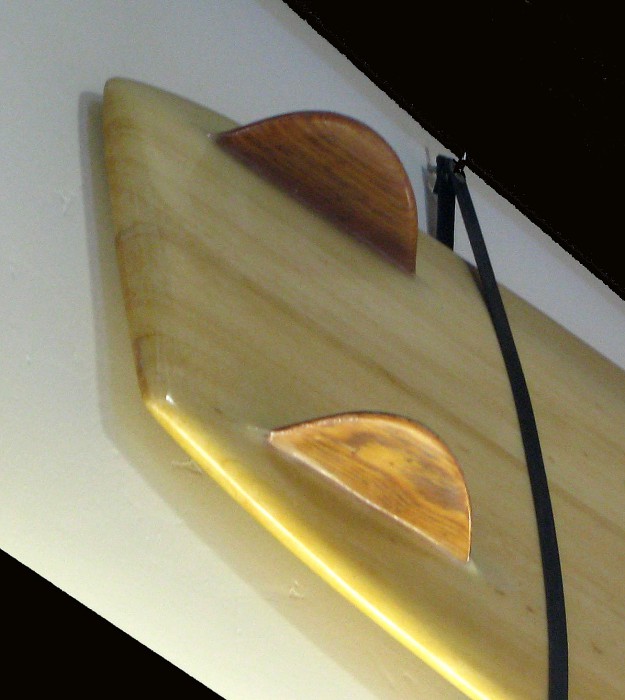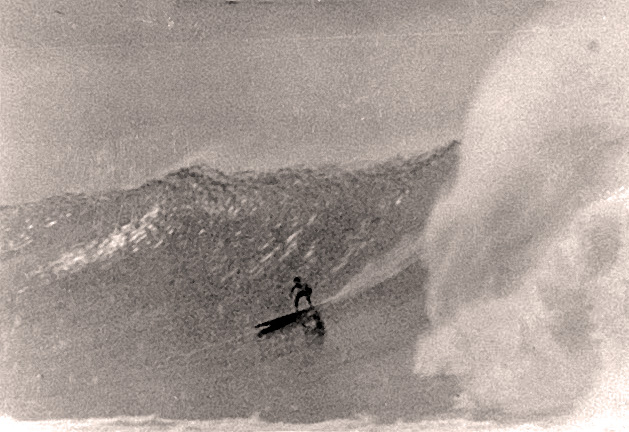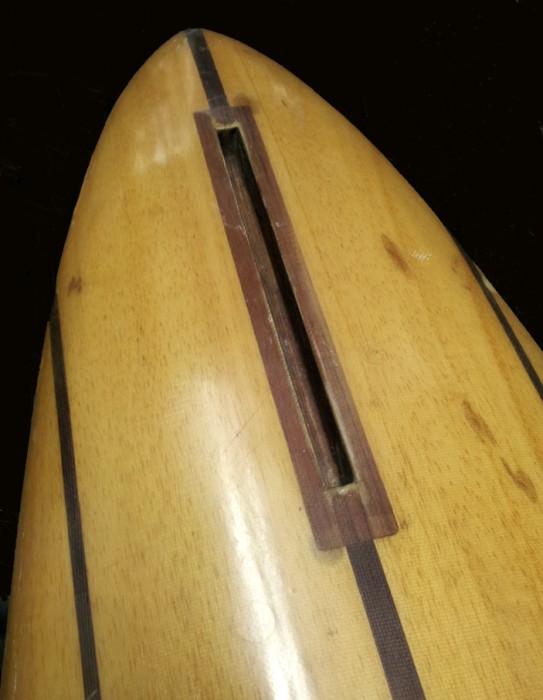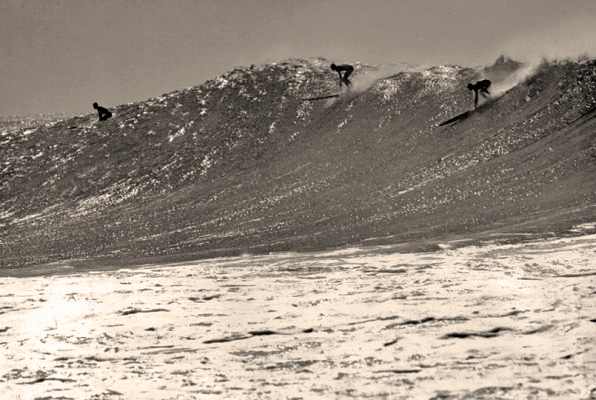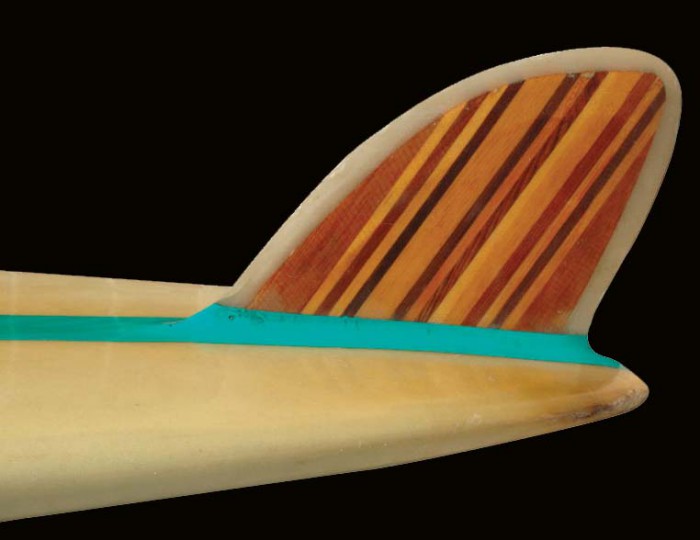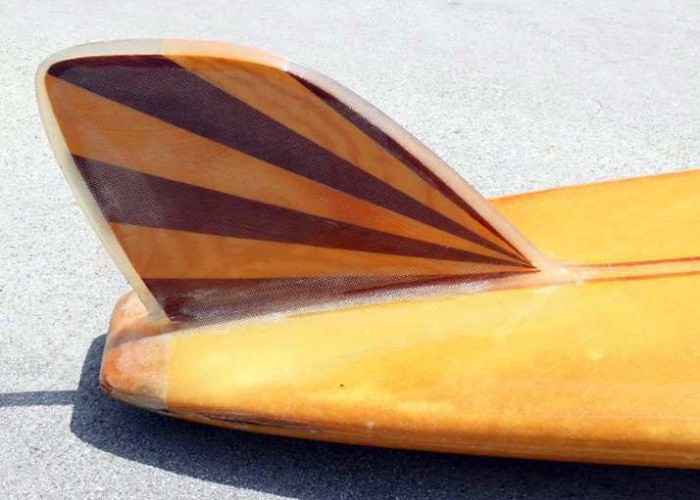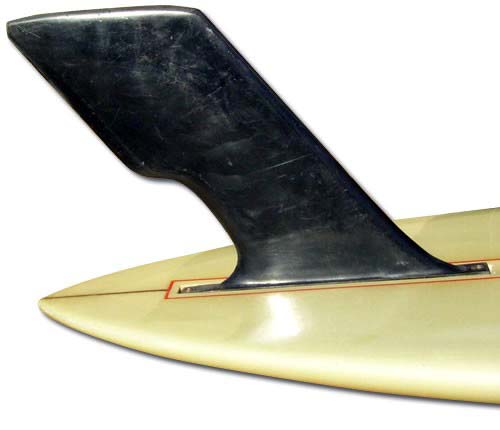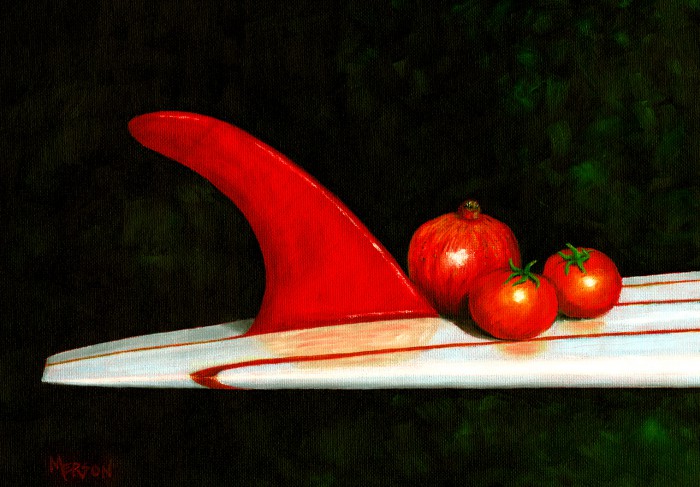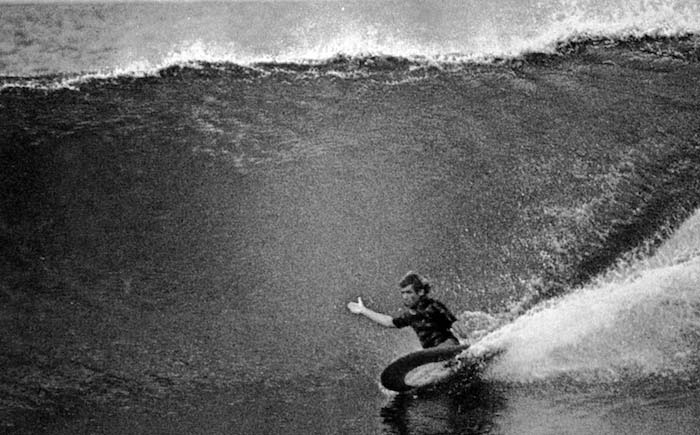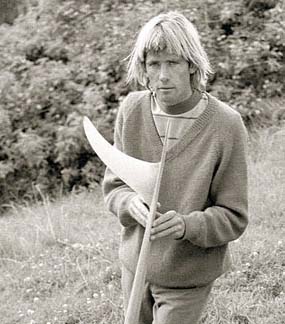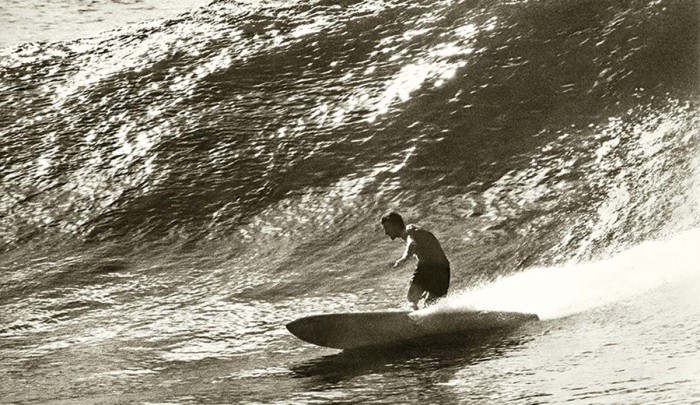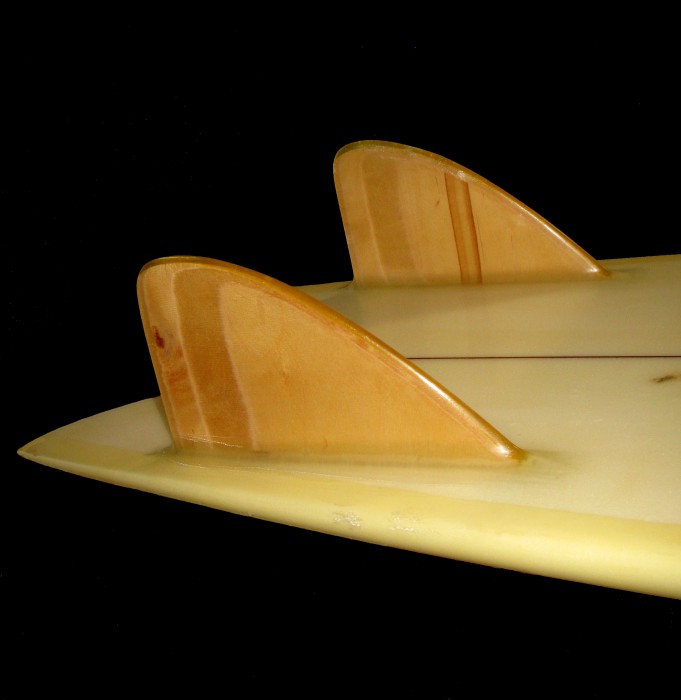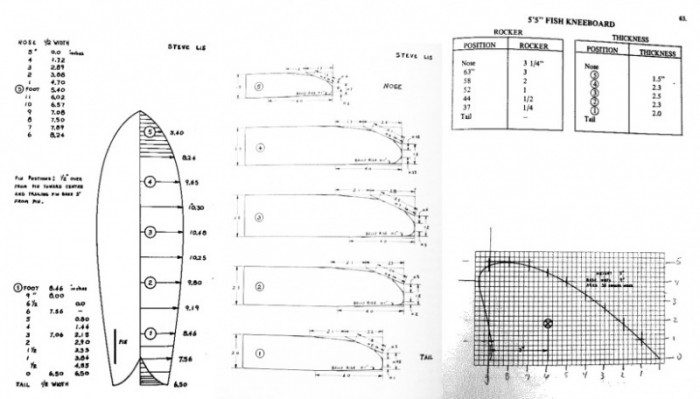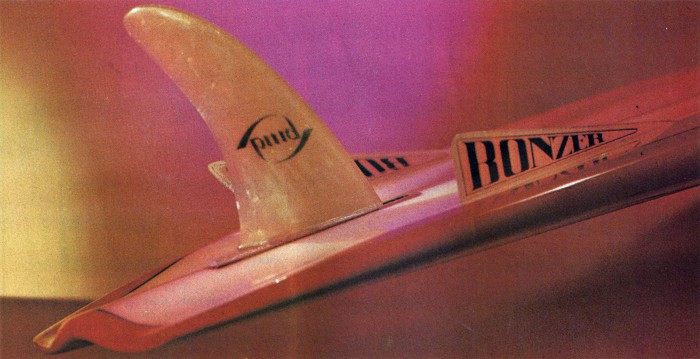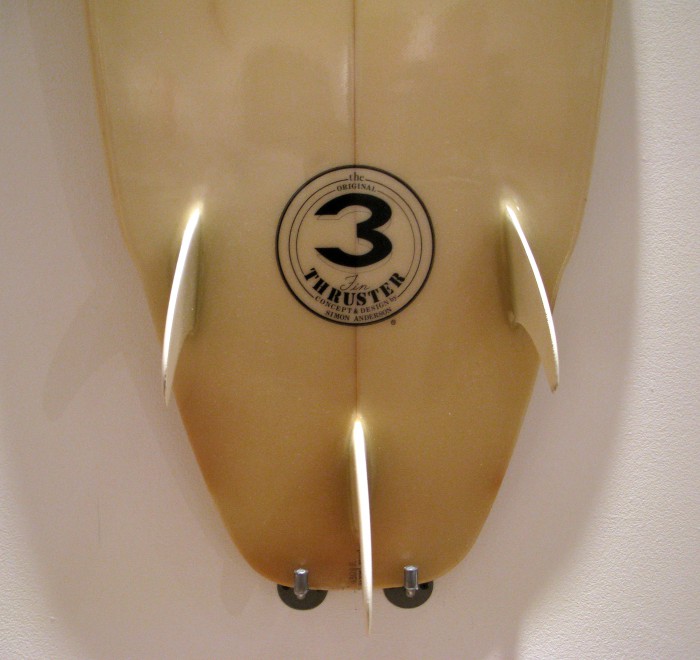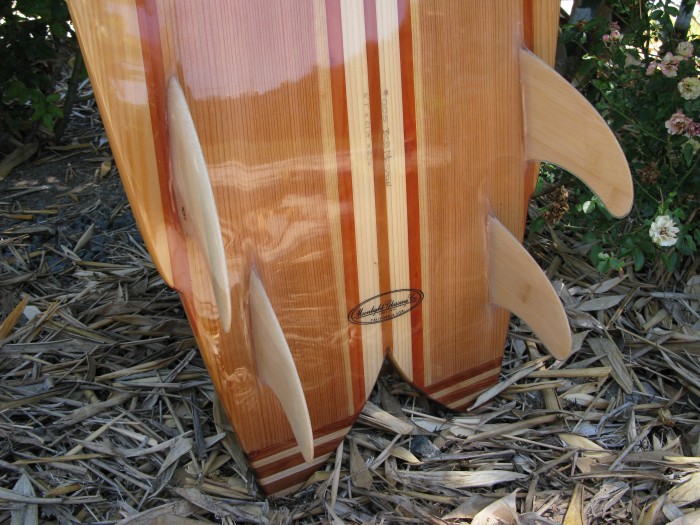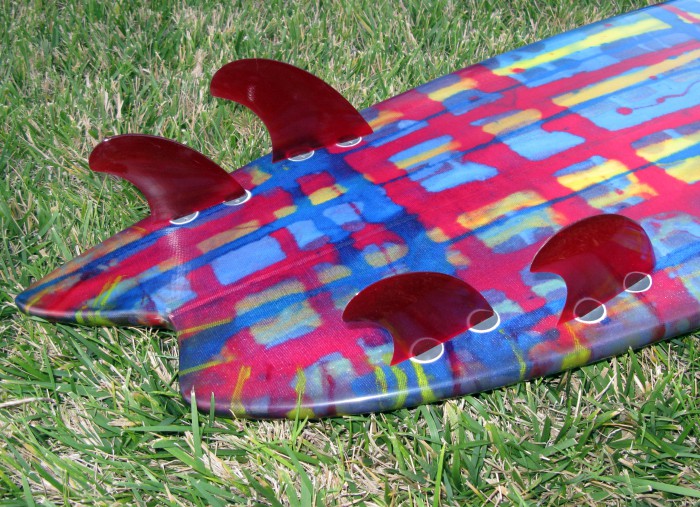jueves, 31 de diciembre de 2015
miércoles, 30 de diciembre de 2015
martes, 29 de diciembre de 2015
lunes, 28 de diciembre de 2015
domingo, 27 de diciembre de 2015
sábado, 26 de diciembre de 2015
viernes, 25 de diciembre de 2015
Noserider Fundamentals Tyler Hatzikian on the art of building and riding traditional longboards by http://www.surfermag.com
Noserider Fundamentals Tyler Hatzikian on the art of building and riding traditional longboards

Ideal Conditions: “The
best conditions for this board are basically ankle-to-head high. The
reason being the lift and drag, because when you ride it in a bigger
wave the board is coming up out of the water and actually going slower.
You basically want to ride this board in smaller conditions where the
board doesn’t have to go as fast or the wave is not going to allow you
to go that fast, because the faster you go with it, the more it comes up
out of the water and slows down. These are all the different elements
of lift that are incorporated in the design.” Photo: Balzer

Proper Technique: “This
board is meant to be ridden in a very traditional manner. A 10-foot
board probably weighs about twenty-five pounds. It’s made to be really
quick on fade turns. Because of the tail rocker and outline curve, you
can start that turn a little higher and project into the crease of the
wave rather than drop straight in down into the flats and making a turn
like you would on a down rail edge, flat bottom board. These are surfed
more off the rail, which is a fifty-fifty rail, and the fin serves as
just a stabilizer. The traditional way to ride it is to start with a
fade and as you project out of that turn, you come up the face and into
the vertical part of the wave. Then you run straight to the tip and
stick it there as long as you can, which is when all of those lift and
drag elements come into play.” Photo: Balzer

When
the waves are small, it’s hard to beat a traditional single-fin
longboard in terms of fun and function, and there are few individuals
more apt both on the nose and in the shaping bay than Los Angeles shaper
Tyler Hatzikian. “This is
a design I’ve been shaping for a little over twenty years now,” says
Tyler. “It has a lot of the same basic features as when I started making
them, but there have been little tweaks to the outlines, rails, and
thickness. Nowadays, alternative equipment seems to be more accepted.
Back when I was first making these boards, I just tried to separate
myself from the conventions of the ‘80s and early ‘90s. I wanted to
build a board that could advance my traditional surfing and advance my
ability to design and shape. To make something different from the
typical thrusters or longboards of the time, which were basically 9-foot
shortboards. I put a heavy focus on making the opposite kind of board,
and it felt new and exciting and it still does. Because no matter how
much you work at it, the quest for the perfect shape is still pretty
hard to achieve [laughs.]” Photos: Lowe-White

10’ x 23” x 3 ¼” Noserider: “Noseriders
are a balance of drag and lift. It’s basically a board that stalls, but
doesn’t stall too much. If you don’t have the right elements, you could
have a board that is just a dog or a board that is too fast—a board
that once you get to the nose, you’ve already outrun the wave and have
reset your line. This board is made to make a turn, get to the tip, and
stay there without outrunning or getting caught behind.” Photos: Lowe-White

Nose: “The
nose on this model is about 18 ¼”, and it has a 4-foot long concave. A
lot of spoons are just a blended type of oval, but this one has a
distinct edge around the concave so it cuts a straight line right down
the stringer, which is kind of unique. It basically has it’s own planing
surface and it creates a good amount of lift, which is required for
good noseriding. Also, having an edge on the concave allows the water to
release instead of cavitate. If the water gets trapped in that concave,
you get too much drag.” Photos: Lowe-White

Bottom Contour:
“Some of the things that help balance speed are the concave and the
tail rocker, which creates a certain amount of drag so that you’re not
outrunning the wave. Because of the tail rocker, the water has to wrap
around the bottom of the board and out the back of it. The water
actually kind of has to go uphill as it flows past tail, which gives you
lift also. The nose rocker on this board is a little bit flat, which
allows the concave to be a little bit shallower. If you had a lot of
nose rocker and you had that straight concave, the concave would be way
too deep. So there is a balance between nose rocker and flat concave.
The way I have it dialed, all of those things have to be accurate within
an eighth of an inch. If you have too much one way or the other, it’s
either too fast or too slow.” Photo: Lowe-White

Fin:
“The fin I put in there is kind of a wider pivot fin. The leading end
of the fin and the trailing edge are fairly parallel to each other. The
straight trailing edge creates kind of a certain drag also, but the main
thing with the fin is that is doesn’t have a rake. It’s pretty much
straight up and down, which allows you to break the fins side to side,
when you’re on the nose. If you’re trying to adjust or turn from the
nose, the straight up and down fin will go laterally a lot easier so you
can break your line from high in the face or banking and going around
the section. If you had a fin that had a lot of rake, it becomes tracky
because it’s hanging way out from behind the tail and it makes it kind
of stick when you try to turn. It’s placed right on the tail block and
the reason for that is because it’s the narrowest part of the board. A
lot of people think if you move the fin forward, its going to be looser,
but actually when you push the fin forward, you are in a wider part of
the board making it harder to turn. I put the fin all the way back in
the narrowest part of the board, so with a combination of curve in the
outline and tail rocker, you have a really loose turning board.” Photo: Lowe-White
Tom Morey's Noserider Contest Ventura, California. 3 - 4th July 1965 By Surfsearch.com
Ventura, California.
3 - 4th July 1965
Selections from Surfer Magazine
January 1965 -January 1966.
| Tom Morey's Nose
Riding Contest at Ventura in mid-1965 had a significant impact on
Californian surfing technique and surfboard design until 1968, when the
American market was substantially challenged by the influence of "short-board
revolution", commonly thought to have originated in Australia in mid-1967.
Morey designed the
contest to apply objective judging criteria to performance and encourage
board designers to concentrate on one specific design feature.
Cash prizes were awarded for categories of stock and special boards, goofy-foots and naturals, individuals and teams. Performance was judged with a watch - timing the rider on the front 25% of the board" (designated by a coloured deck patch or band), accumulated on a maximum 14 waves. Existing film confirms much of the subsequent written accounts of the contest and also indicates that the collation of the scores was, at best, rudimentary. Many thanks to Ben Marcus for providing this important archival material. |
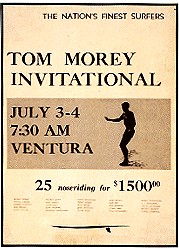
(1997), page 103. |
In the case of the non-functional tail extensions (simply an exposed timber stringer sticking out of the tail of the board) the designers removed these with a hand saw before being allowed to compete, following animated and vigorous discussion with Tom Morey.
Furthermore, one board had a footstrap fixed to the nose, but the contest footage indicates the rider had considerable difficulty in fully exploiting this feature.
Footstraps became an essential addition in the 1970s for windsurfers when they began to ride their boards in serious surfing conditions and are standard features on tow-in-boards and kite boards. On the day, the Hobie Surfboards team, riding a number of boards specifically designed by Phil Edwards, won both natural and goofy first places.
However, "by a judging error ; Mike Hynson of San Deigo actually won."
- Kampion: Stoked (1997) page 103.
Surfer Magazine first reported on the Morey Noseriding Contest in September 1965 in an article by Patrick McNulty: "Their surfing for big contest $$$"
Surfer Magazine September 1965, Volume 6 Number 4, pages 64 to 69
Page 69
...
Surfing's trend to professionalism was underscored over the Fourth of July weekend when the Tom Morey Invitational scattered hard cash for some of best surfers in the sport.
Thee contest was really unique- not only for offering cash prizes.
The 24 specially invited surfers who put up a $50 entry fee to back up their reputations were judged solely on nose riding.
They were graded on exactly how long- by a stop watch- they could ride the nose across Ventura Point waves.
The contest brought out some weird, specially-built boards as well as such surfers as Corky CarroII, Donald Takayama, Robert August, Dewey Weber and Mickey Munoz.
Nose-riding off with the top prizes were Munoz and goofy-footer Corky Carroll.
There were two divisions -Regular and Goofy-Foot.
After the Morey contest the stoked "professional" surfers raised the battle "On to Lahaina."
Another nose-riding contest is planned for this famous whaling port on the Hawaii island of Maui in the fall.
The contest is planned along the lines of the Ventura contest with entry fees and a pot of gold worth $7000.
It looks as if the old days when surfing contests were held just for fun and not for profit are long gone.
Evidence that the projected contest on Maui ever eventuated is, currently, unclear, however there is a report of a second noseriding contest held at Ventura in November, 1966 (see below).
It was about another ten years before McNulty's prophesy, that surfing was about to enter a professional competitive era, was fully realised.
In the same edition of Surfer, Hobie Surfboards offered a teaser to the up coming release of their noseriding model on the prestigious page two, inside the front cover.
Hobie Surfboards: What are they talking about? (Advertisement)
Surfer Magazine September 1965, Volume 6 Number 4, page 2.
Under a photograph of the team members sitting around several boards on the beach, the text read:
What do you think they are saying? -They are saying, be serious, our picture is being taken.
But what they really have been talking about lately is the new model HOBIE SURFBOARD that will be out soon.
We wish that we could tell you more about it, but we still have some more experimenting to do.
We do feel that we have discovered something big in surfboard design using a new principle in bottom shape.
In the past we have the mistake of bringing out some things too quickly, but other innovations we have taken too long to introduce and have been copied so fast that no one knew who originated the idea.
We feel that our new board is worth protecting as it well could be the basic design for all future surfboards.
By the next issue of SURFER we should have it perfected and available.
The HOBIE SURFBOARD SHOP was the originator of the modern surfboard and first with a signature model (Phil Edwards).
We are first in competition, too.
So far this year we have compiled 58 points in overall USSA competition to our next competitor's 34 points.
Now with a new shape of surfboard, designed by Phil Edwards, we may be first in revolutionizing surfboard design.
The next edition of Surfer was designated as an "Special Nose Riding Issue", featuring several pertinent articles and advertisements by surfboard manufacturers.
Bill Cleary looked back at the Morey Contest in "Nose Riding - A sport within a sport."
Surfer Magazine, November 1965, Volume 6 Number 5, pages 24 to 35.
Page 29
...
The Tom Morey Invitational (held in July at Ventura, California) provides us a good example, for here was a contest devoted exclusively to noseriding.
Twenty-two of California's best surfers were invited to participate for $750 in cash prizes.
Twenty-five percent of the board's length was defined as the nose.
Those surfers who spent the most time on the nose, as measured by judges with stopwatches, were the winners.
This was the first surfing contest ever held in which a winner was determined by objective criteria.
But the real importance for development of the sport was that there were "no equipment restrictions."
Manufacturers were stimulated to create a specialized surfboard -one designed to be ridden most efficiently on the nose under the surf conditions at a specific surfing spot.
There were categories for stock boards and special boards, left-foot leads and right-foot leads.
The special boards ran away with it: Munoz (Hobie Surfboards), Hynson (Gordon and Smith Surfboards) and Carroll (Hobie) clocked noserides of 9.9, 9.8 and 9.6 seconds, respectively, while in the stock board class Nuuhiwa (Bing Surfboards) and Leonardo (unknown) tied for the longest nose rides at 5.8 seconds.
The vast difference in performance between the two classes cannot be explained by a greater or lesser ability on the nose.
The answer is - Equipment: and all ...
Page 32
... the prototype boards designed by the various manufacturers functioned beautifully.
Page 35
...
So watch the new boards.
Watch the new surfers.
A new era of nose-riding may be at hand.
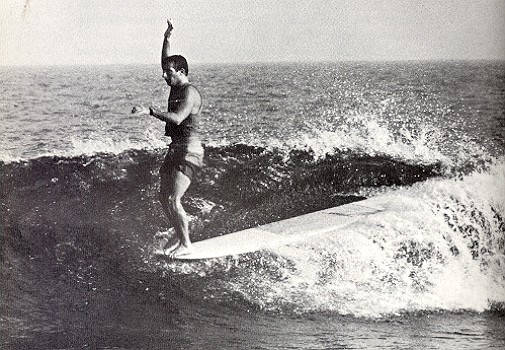 |
Tom Morey's Nose Riding Contest, Ventura, July 1965. Photograph by Bruce Brown. Edwards (1967) page 122. |
| Corky
Carroll and Hobie Nose-Rider, Poche, July 1965.
Photograph by Ron Stoner Kampion (1997) page 105. For Corky Carroll's comments on the Morey Noseriding Contest, see: Surf-Dog Days and Bitchn' Nights, page 48. The fleet of boards prepared for Hobie Team members by Phil Edwards and Hobie Alter featured a deeply concaved nose design and its competive success and advantages were heavily promoted in advertisements and articles. Phil Edwards gave a brief, but erudite, technical analysis of the design's development to Bill Cleary for his "Nose Riding - A sport within a sport" article. Surfer Magazine, November 1965, Volume 6 Number 5, page 26. |
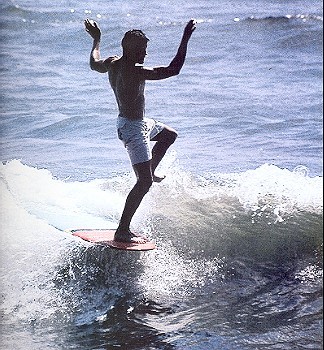 |
The radically new board ridden by Mickey Munoz, who won the event, was so successful that
manufacturer Hobie Alter patented it. Designer Phil Edwards explained that it was not the ideas behind the board that were unique, but collective application of them.
He credited the board's basic ideas to an earlier inventor: "Simmons was the only one who ever took a real academic approach to the thing (design).
What he did with surfboards is still pretty much what we're riding today.
In fact, the best way I can describe our noseriding board is a Simmons board with the nose cut off - a speedboat turned backwards with planing lines in the front.
It had all been done before ... but never quite like this.
We put it all together deliberately: the big, wide nose, the concave area, the flat bottom up there - all to make the surfboard trim on the nose.
In preparation for the contest we built three other models that had more or less emphasis on one of the three elements.
And they worked.
But the really dramatic results came from putting all three elements together at one time with a single purpose in mind.
I was really proud of it."
| Whereas seminal
Californian board builder, Bob Simmons, had used significant concave in
the tails of his renowned wide-tailed Spoons of the late 1940s- early 1950s,
Edwards relocated the feature to the nose.
Simmons had based
his designs on his treasured copy of Lindsay Lord's Naval
Architecture of Planing Hulls (1946).
Many of the models and diagrams in the book appear similar to Simmons' boards, emphasizing the increase in lift by incorprating parallel running lines, page 71. Right: Figure 29: M2 Illustrates one of Lord's models (M2) that features nose scoop, concave bottom and twin keels (fins), page 72 |
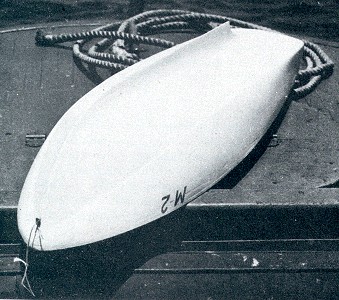 |
Edwards reprised the story of his design for the Morey contest in The Great Nose-Rider Caper, Chapter 11 of his autobiography, You Should Have Been Here An Hour Ago in 1967.
The chapter begins with a basic illustration of the design.
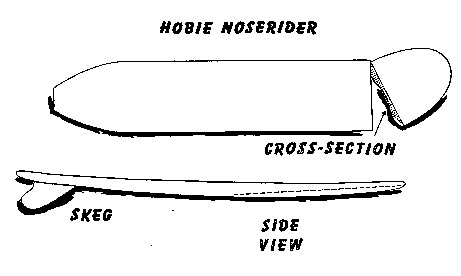 |
1965. Edwards (1967) The Great Nose-Rider Caper Chapter 11, page 169. |
Following Simmons, other designers had used concave sections in the bottom of their boards, noteably a deep concave in the tail of big wave Gun boards usually associated with Dick Brewer at Bing Surfboards circa 1963.
In the May 1965 edition of Surfer magazine Dewey Weber surfboards advertised the "Standard and Gun models with the newly tested 'Concave Bottom'" priced at "an additional ten dollars", presumably introduced by the company's featured shaper, Harold Iggy.
An accompanying photograph is unclear as to how this feature was incorporated into the overall design.
- Surfer Magazine, May 1965, Volume 6 Number 2, page 4.
The same issue also had an advertisement from Surfboards Hawaii, Honolulu and Haleiwa, featuring Butch Van Artsdalen on a "small wave concave".
- Surfer Magazine, May 1965, Volume 6 Number 2, page 98.
In both instances, neither advertisement identified the addition of a concave bottom with enhanced noseriding performance. In Surfer's "Special Nose Riding Issue", Hobie Surfboards promoted the noserider design (hinted in the previous issue), as usual, on page two inside the front cover.
Some of the accompanying images are reproduced below (cropped):
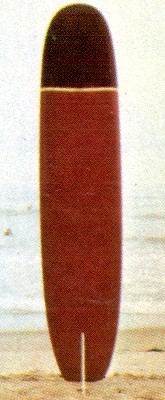 |
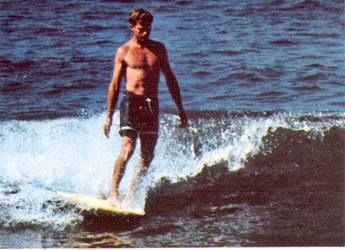
Hobie Noserider designer, Phil Edwards. Surfer Magazine November 1965, Volume 6 Number 5, page2. |
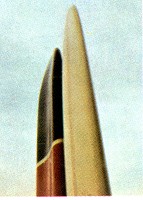 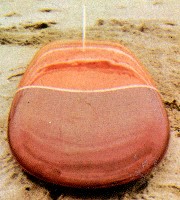 |
The advertising copy read:
The Hobie Surfboard Shop has come up with a new design in surfboards called the Noserider.
The Noserider, designed by Phil Edwards for Mickey Munoz and Corky Carroll to use in the Tom Morey Invitational riding contest, proved itself completely.
Mickey and Corky took top honors in both their divisions by compiling the most time on the nose and the longest individual nose ride.
The competition was among top surfers riding specially designed boards by the manufacturers they represented. The difference in design between the Hobie Noserider and other boards entered in the contest was that all other makes of boards were variations of the standard principal of nose riding surfboards.
They had wide noses with good scoop and a fair amount of belly.
The Hobie Noserider was based around a completely opposite theory -no scoop, with a flat planing surface on the front third of the board and a concave bottom in that area.
The reason for the board's superior performance is that by having a flat planing section, it doesn't push water and lose speed.
By maintaining its speed, it maintains its lift.
The board also gains addtional lift by the concave bottom section.
The board shown above is one of the radical versions with a wider nose and is wider over-all.
This board has proven to be an exceptionally fun board, especially in fast shore breaks.
The more practical model is our conventional noserider has the same shape as our standard boards, with the concave, flat bottom section added to the nose area.
This makes for an all-around performance board with superior noseriding qualities.
This board is not shown because we were working on variations of it at the time the pictures were taken.
For further information on the Hobie s Noserider, contact your local Hobie dealer.
In the same issue of Surfer, Con Surfboards of Santa Monica included in the list of current design features:
"Now available, CONcaved nose boards - a new concept in surfboard design for the ultimate in nose riding.'
- Surfer Magazine, November 1965, Volume 6 Number 5, page 15. Morey's contest, and the subsequent advertising, was a spectactular success that established noseriding as the epitome of small wave surfing skill, at least in California.
Noseriding models (most variations of the concave-nose Hobie design) proliferated by all the mainland manufacturers:
The Eliminator by Greek Surfboards
The Ugly by Con Surfboards (see below)
The Penetrator by John Peck/Morey-Pope Surfboards
The Performer by Weber Surfboards, and
The Stretch by Gordon and Smith Surfboards.
These variously featured a combination of flat nose rocker, narrow high kicked tails, and concave noses and/or stepped decks.
Importantly, the Snub, a post-contest noeriding design by Tom Morey, was one of the first designs to have low rails in the front half of the board.
| 3. SNUB.
The radical contours of the SNUB make great maneuverability, speed and 30 second noserides possible on one board. True, the SNUB looks strange, but so did a jet the first time you saw one. Text and image from: Morey-Pope Advertisement titled "Inventions". Surfer Magazine, January 1966, Volume 6 Number 6, page 66. The other inventions detailed in the advertisement were #1 The Trisect and #2 Slipcheck, an aerosol wax replacement (see below). |
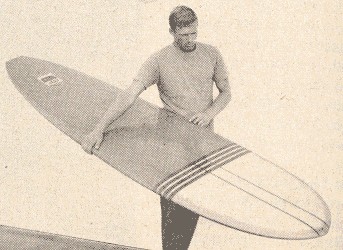
|
| 2.
SLIPCHECK.
A fine textured coating for the nose or tail of your board which is so firm when wet it completely eliminates slipping. Apply SLIPCHECK once, touch up occasionally. For sale in white only. One can, $3.50, is more than enough for initial coat plus touch ups.  |
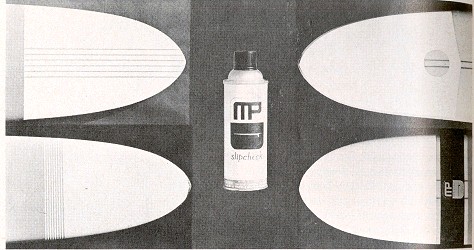
Morey-Pope Slipcheck Advertisement titled "Inventions". Surfer Magazine January 1966, Volume 6 Number 6, page 66. Image right: Slipcheck aerosol can, circa 1968. Source unknown.
i
|
Nose riding also encouraged experimentation in fin design, notably the Hatchet and the Turbo fins by Dewey Weber Surfboards, with further encouragement for the use of fin boxes, such as Morey's Skeg Works, which was later developed into his Waveset system.
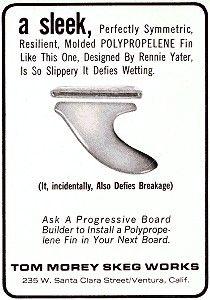 |
RennieYater
Fin by Tom Morey's Skeg Works
Polypropelene 8 x 9 1/2 b @ n/a inches (Approximation) Advertisement for Tom Morey Skeg Works 235 W. Santa Clara Street, Ventura, California. Surfer Magazine July 1965, Volume 6 Number 3, page 69 . |
Other fin designs included:
Tiger Tail fin by Greek Surfboards (Tiger Espere)
Flow-thru fin by White Owl Surfboards, and
Eliminator fin by Greek Surfboards (for their Eliminator Model). Unaccredited, and unexplained, fin designs at Morey's contest included the use of "additional contol skegs" and the "fin stabilizer":
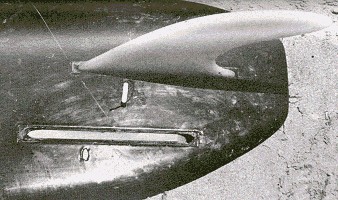 |
"additional
control skegs"
Offset Fin Boxes ? Polypropelene 8 x 9 1/2 b @ n/a inches (Approximation) Unaccredited. Bill Cleary: "Nose Riding - A sport within a sport." Surfer Magazine, November 1965, Volume 6 Number 5, page 33. |
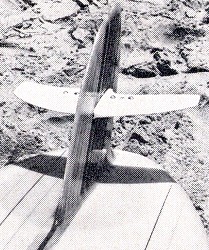 |
Fin
Stabilizer (on D fin)
??? 8 x 9 1/2 b @ n/a inches (Approximation) Unaccredited. Bill Cleary: "Nose Riding - A sport within a sport." Surfer Magazine, November 1965, Volume 6 Number 5, page 33. |
The "fin stabilizer" was a precedent for the "Noselifter", a late 1960s fin accessory that was an ajustable horizontal foiled blade, about 3 inches wide, that attached to the fin and was said to improve noseriding by increasing tail drag or tail lift.
It was marketed by Surf Research in California (Gareth Powel, Mike Doyle and Rusty Miller) and advertised in
Surfer/Surfing magazines of the period.
Rusty Miller, noted by email February 2008:
"Neat to be reminded of our "Noselifters" as I remember we called them... They were injection molded
symmetrical (black and white) and their plane was made adjustable by one of the two screw holes
through the fin where they were attached by... Being made into a slot shape... So one could adjust the
level of drag desired."
Many thanks to Rusty. A nose patch, a marked section of the front 25% of the board, became a common decor feature.
Manufacturers often added these, usually with coloured resin and some times a fabric inlay, but many riders added the decor to their boards post-production.
This was a excellent marketing tool for Morey-Pope's coloured aerosol wax alternative -Slipcheck
and its competitor, Grip-Feet.
The extraordinary noseriding talent of David Nuuihwa (Bing Surfboards) elevated him to near God-like status in the Californian surf media and the description "genius" was not unknown.
See McGillvay and Freeman's Free and Easy, 1966.
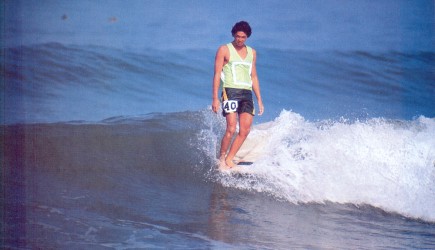 |
Photograph : Leroy Grannis Surfing Magazine March 1984 Volume 20 Number 3 page 82 |
Phil Edwards' design and a host of variations, often with a decor nose patch or an application of Slipcheck, were introduced to Australia by 1966.
Footage of the 1967 Australian Titles, Bells Beach Victoria in Paul Witzig's Hot Generation (1968) shows the boards of Robert Connelly and Keith Paull with nose patches, possibly applied with Slipcheck.
Perversely, non-competitor Bob McTavish's Keyo had Slipcheck panels in the centre of the board.

The direction is involvement.
Getting into tight spots - under, in, over, around the curl, quite often in contact with it
And getting back out of them.
The more involved you are...the hotter you are.
Bob McTavish: bob mctavish is in this wave. he probably had a plan to get out of it
Surfing World magazine January 1967 page 15. Morey's Second Noseriding Contest, November 12th, 1966.
The following account may contain some inaccuracies.
Note that variations of the "10 pound bar-bell taped to a tail, and a 'Wing' attached to a fin" had already appeared at the first contest, the former (a house brick) a noted failure.
From:
http://www.theuglyclothingcompany.com/theuglylegend1.htm
It's the crack of dawn on Saturday, the 12th of November, 1966.
Most of the audience, about two thousand people, gladly pays an entrance fee of $1 to see the performances of fifty top professional surfers from around the world, who gather for the Morey-Pope 2nd United States Professional Invitational Surfing Championships at the Ventura Fairgrounds surf spot, locally known as "Stables."
Each of the fifty competitors and their surfboard manufacturer/sponsor(s) have the intent to push nose-riding-for-time to the extreme.
Every surfboard manufacturer has dug deep to come up with the ultimate nose-riding design.
The rules are simple but madness abounds.
Some strange designs appear; beside a 10 pound bar-bell taped to a tail, and a "Wing" attached to a fin, there are other oddities.
The objective timing system provides fair judging, which satisfies the contestants and gives the captured crowd a simple to understand test of skill.
The winner is anticipated to generate more publicity than they have ever known, great money and prizes.
Perched like casual Gods on the nose, striking ethereal poses in effortless motion, the competitors clock incredible distances, drawing an ever building thunderous cheer.
Con Colburn, of Con Surf House, is the manufacturer of a top-secret design.
With Bob Purvey, a top competitor, at the helm, they have collaborated to devise what seems to them the logical curves necessary to accomplish their goal: TO WIN!
On the last ride of the day Purvey catches a five foot wave "..turned high and went to the nose, the section came up, he backed off, dropped, repositioned himself with two steps and came out on the nose.
Then the wave broke ahead and he straightened off then turned into the wave and clocked two more seconds while in the soup.
He made no mistakes whatsoever." (from Competition Surf Magazine, Spring 1967).
Crowds ring Purvey, not to shake his hand but to check out his stick.
It's March, 1967.
In a full page ad in Surfer magazine Con introduces the board and summarizes the contest and the Ugly design: "It's called 'the Ugly'.
Bob Purvey out rode the top professionals in the 1966 U.S. Championship Invitational Nose-riding contest at Ventura, with the highest nose-riding time of 41.5 seconds for 6 waves.
An average of 7 seconds per wave. Purvey won the admiration of every rider and surfboard maker for his superior wave knowledge and ability. Bob gives the credit to his UGLY.
AD TEXT:
EVERYBODY WANTS IT ANYWAY!
No matter how you look at it, the only thing beautiful about the UGLY is the way it handles in the water.
There is certainly nothing handsome about the twenty inch nose one foot from the tip, able to support full weight on take-off or cut-backs.
Beauty prizes will never be given for the parallel rails that holds smooth trim as the board glides down the wall of any wave, or give precision control in turning from the nose.
And the really Ugliest part is the silly looking, scooped-out popped up six inch square tail that sets into the water and causes downward pressure exerted on the tail for opposite reaction to the nose.
What we are trying to say is that nobody cares how it looks, because it was designed for function as an all around board as well as a nose-rider!
See the ugliest board ever built at your local Con Surfboard Dealer."
Nose riding models were reproduced in the 1990's with the increased popularity of the modern Malibu.

Tyler Warren hanging at the Temple DEUS
Since his art exhibit at the Deus Gallery, Tyler Warren has been hanging out around the Temple, drawing, surfing and shaping. In his time within the shaping bay he managed to bust out a couple of shapes for himself, and has been giving them the rundown in the water over the past week or so.
“I have been shaping a variety of boards lately. Everything from 4’11” twin fins and mid length eggs to 11′ gliders. My goal in any board is to make it fast, fun, and responsive. Since I have been in Bali I shaped a 5’1” Bar of soap which is a fast planning surface (mini Simmons inspired with a 11inch tail block… I then made a 9’4” 1966 “Magic Sam” style longboard…No concave with pinched 50/50 rails and a flat deck line rolling with a high aspect Greenough style fin. These boards work best in the pocket. I shaped it and laminated it in 2 days with help from the Deus crew and rode it on sunday for the 9′ foot over comp. It was great to see a surfboard appear under your feet that fast. Now I am working on a 7’4” mini glider.”A glassed in twin fin and a 9’4 nose rider are now part of his quiver, and the first time he took the log out, he managed to clinch a win at the 9ft & Single event. Here are some snaps of him riding the pair and a little overview from the man himself.
Tyler is going to be around for another week or so, and has already received a screed of custom orders, so if your looking for what he’s crafting, drop an email to info@deus.co.id!
http://deuscustoms.com/blog/tyler-warren-hanging-at-the-temple/
jueves, 24 de diciembre de 2015
miércoles, 23 de diciembre de 2015
martes, 22 de diciembre de 2015
sábado, 19 de diciembre de 2015
viernes, 18 de diciembre de 2015
jueves, 17 de diciembre de 2015
Challengers "The Wedge"
What Murphy says...
We loved making music together... and that feeling came across with our audience. Folks got up and danced!
Here's a link to "The Wedge"
https://www.youtube.com/watch?v=9ZFb1MaC2Go
Thank you Rick Griffin for the art. The "Murphy" cartoon ran in Surfer Magazine. The Challengers Band
Copyright Nauert Griffin Card Co.
We loved making music together... and that feeling came across with our audience. Folks got up and danced!
Here's a link to "The Wedge"
https://www.youtube.com/watch?v=9ZFb1MaC2Go
Thank you Rick Griffin for the art. The "Murphy" cartoon ran in Surfer Magazine. The Challengers Band
Copyright Nauert Griffin Card Co.
martes, 15 de diciembre de 2015
lunes, 14 de diciembre de 2015
domingo, 13 de diciembre de 2015
You Need a Small Wave Quiver by Ross Phillips Surf Coach
You Need a Small Wave Quiver
http://ross-phillips-surfs.com/you-need-a-small-wave-quiver/
For a long time I didn’t surf.I lost interest because the waves were often too small, fat and nothing to get excited about.
But I changed that by expanding my quiver.
I really love Joel Tudor’s philosophy to surfing… “choose the right board for the right conditions.”
I don’t buy into this whole shortboard/longboard division. The waves are always different and choosing the right board for the right conditions will not only give you more enjoyment, but also help you learn about board design, surf in new and fresh ways, allow you to explore different facets of the sport and improve your surfing.
One of the most exciting shortboarders on the WCT today started his career as a longboarder. Julian Wilson spent most of his youth honing a beautiful style on the point breaks of Noosa. Learning to ride a longboard in small waves is a great way of smoothing out your style. Try to surf with a ‘less is more’ focus. Buy that I mean minimum body movement, and simply maneuvering your board using heels and toes from the tail rail. If you can later apply these skills to a shorter board, you’ll be ripping with increased grace and style. Longboards teach us to turn from the tail with patience. Shortboarders who never try this tend to break from the waist without an ability to hold an arc or draw out a turn. Consequently a classic 9’2 nose rider is definitely in my quiver. Surfing is all about style and there’s no better place to learn this.
Also in my quiver is a Tom Wegener wooden, finless alaia. The thing is so damn hard to ride that I can go out on a 2 foot day and be totally challenged. Just the simple art of catching and riding a wave requires a lot of skill. Given that I like to be challenged, therefore I leave these sessions feeling stoked just to have caught a couple of waves. If you like to be challenged too (and I know you do), don’t always try to make surfing easy for yourself.
I love my 5’6 Channel Islands fishcuit too. This little thing skates across dead sections with incredible speed. It’s super short and wide so it forces me to surf in a different way – more off the front foot, less vertical, and I have to really concentrate on tipping the wide board onto the back rail with a lot of back heel pressure and ankle roll in order to cutback effectively. For me … front foot horizontal is a new way of surfing so it feels fresh and I get excited about surfing again. Even if the waves are 1 foot. If you want to get excited by exploring surfing from a fresh, new angle, try a board that’s radically different to what you normally ride.
Lots of people bag Stand Up Paddling. But I love it. Always have. Firstly I love the fitness. I have a theory that a lot of surfers who like SUP are also people who like to keep fit through a variety of training. I find SUP balances out my surfing muscles and is a great form of training. I also love the fact that I can go ride a 6-inch wave for 100 metres in a relaxed, perfect glide and trim – which is the pure essence of surfing. Nothing worse than seeing a shortboarder frantically bouncing up and down on a one foot wave. It looks so ugly. If you’re doing that, it’s time to follow Joel’s advice. SUP also teaches you to turn from the tail rail… which is like the secret to turning any board. If you hate it, it’s probably because you’ve never actually tried it.
So … these are just a few of the ways I get excited about small waves. There are tons of boards you can try. Single fins. Twinnies. Finless. Old logs. I really like the look of the new 3’6 Bing Speed Square. How cool is that thing?
At the end of the day, if it’s 6 foot and barreling, I’m always going to go grab my favourite 6’0’. But the message here is don’t be afraid of trying new boards… even if you have not mastered your own board yet, this is a way to improve your skill and knowledge base. Don’t discriminate. Do broaden your horizons and capabilities. Do choose the RIGHT BOARD FOR THE RIGHT CONDITIONS!
I’ve had numerous students who’ve tried a new board while doing a surfing lesson with me and then wondered out loud what the heck they’d been doing for the last ten years.
Ross
http://ross-phillips-surfs.com/you-need-a-small-wave-quiver/
HISTORY OF THE SURFBOARD FIN!!! By THE FIN BOX.COM
An abridged history of the surfboard fin.
http://www.thefinbox.com/history/history-of-the-fin/
No one knows when surfing started. It could have been the first time man entered the ocean out of curiosity or perhaps looking for diner. As he stood in waist deep water marveling at the fish and kelp he was pulled at first into deeper water and then elevated by a thick fast moving liquid wall. He was pitched forward and upward and then down toward the churning bottom. He bounced off the sand and was washed up by the foaming white water and deposited on the beach. After he shook the sand out of his ears and eyes he realized that what had just happened to him was amazing. The first body surfer stood up and walked back out into the sea.
The first surf craft is thought to be the small reed fishing boats used by ancient fishermen along the coast of Peru. These watercraft were developed over 3000 years ago as a method to get out past the breaking waves and catch more fish. After a successful day on the water the first fishermen were pleased with their new craft until they started back toward shore and were pounded by the waves.
Losing the days catch gave them reason to modify their boats to make them more seaworthy and able to ride the waves into the beach. A bamboo pole was used as a paddle and also a rudder to steer the small craft. As they progressed with the development of their craft and gained experience handling the small boats in the surf, riding the waves back to shore soon became the best part of the day.
The first surfboards were developed by the Polynesians and became very popular in Hawaii during the 18th century. The boards ranged in size from 7’ to over 20’ in length often weighing well over 100 pounds. The boards were hewn from native trees such as Koa, Wili Wili and Ulu.
They had flat bottoms and wide tails. The challenge from the beginning was to make the board go where the rider wanted it to go. If you didn’t want to go straight you were very disappointed because these early boards only went in one direction.
The first major modification to the solid wood surfboard happened in the early part of the 20th century when a young George Freeth decided to take up the ancient sport of surfing. He disliked his 16’ board from the start and eventually cut it in half to make it more manageable. George’s new board was the talk of the Hawaiian beach scene and soon the sawdust was flying as the locals jumped on the next big thing.
Even though the boards were smaller and somewhat lighter they would not turn and only went straight to the beach. George Freeth was the first professional surfer. He was hired by Henry Huntington and shipped off to California to give surfing exhibitions in Redondo Beach to promote Huntington’s Pacfic Electric Railway. George has been referred to as the Father of Modern Surfing and given credit along with Duke Kahanamoku for surfing’s rise in popularity.
The next important design change came in 1929 by Tom Blake. He was frustrated with the traditional, hard to handle, heavy solid wood Hawaiian boards. Tom invented a radical new board that was hollow. Although this new board was 15’ long and weighed close to 100 pounds it worked much better than the solid boards.
After some refinement he shortened the boards and got them down to around 40 pounds. At first it was ridiculed by the surfing establishment of the day, but after seeing how fast it was and the ease with witch it planed across the water, the hollow board became very popular. The board had boxed rails, a flat bottom and a narrow pin tail but it was still ridden pretty much straight into the beach. The boards paddled fast and Blake won many paddleboard races with his new design. In 1931 Tom’s hollow board became the first mass produced surfboard/paddleboard. Tom also is credited with the first surf book “Hawaiian Surfboard” and also as the first surf photographer.
The evolution of the surfboard continued in 1934 when a group of Hawaiian surfers, Wally Frosieth, John Kelly and Fran Heath were inspired by Tom Blake’s design and decided to take things into their own hands. They dramatically changed the tails of their old solid wood boards. They narrowed the nose and tail, modified the rails and shaped the bottom of the tail into a “V” and then later more of a “U” shape.
The new modified tail created suction holding the board in the steeper part of the wave. For the first time the surfer was able to maneuver the board on the face of the wave. The rider could glide out on the shoulder, side-slip and ride in the curl like he could only dream of before. These new boards soon became known as “hot curl” boards.
The first fin was a foot. Even though the hot curl boards were more maneuverable they were difficult to turn and a new technique was developed by the surf riders to help them turn parallel to the wave.
They would drag their rear foot over the side of the rail and into the wave. This would help the board to come around, change direction and angle across the face of the wave.
To say that Tom Blake changed the course of surfing would be a great understatement. In 1935 Tom single handedly turned surfing toward the modern era with his most important design contribution. He attached a fixed keel fin from a small speedboat to the tail of his board.
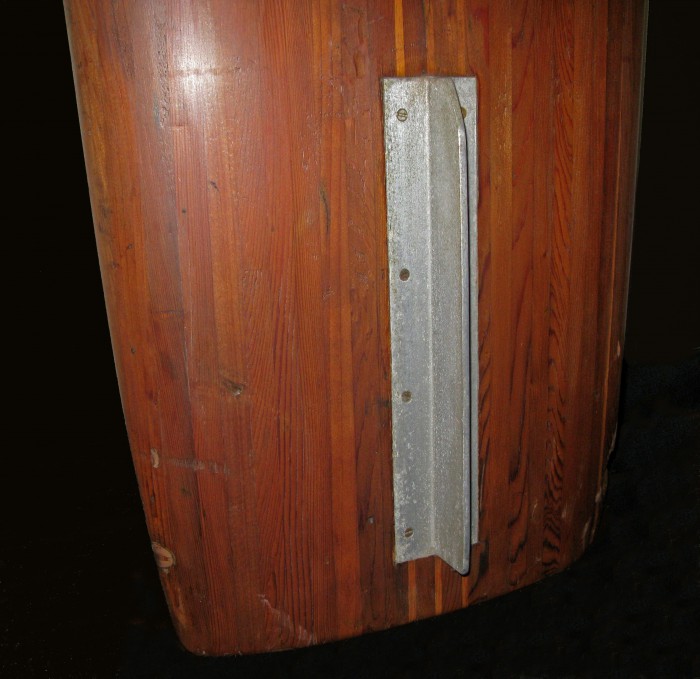
Solid wood board with aluminum keel fin (late 1930’s) Surfing Heritage & Culture Center collection photo: Merson
The keel was 4” deep by 12” long and provided stabilization and control that was previously unknown to wave riders of the day. Woody Brown was also working on a fin at about the same time but Blake was the first to patent the surfboard fin. The new control that the fin afforded allowed the surfer to turn parallel to the face of the wave and hold a tight line without the tail sliding out.
The fin took a while to catch on, almost 10 years, but eventually everyone started carving fins from wood and attaching them to their boards. Tom Blake’s discovery and application of the fixed fin was the greatest design contribution in performance surfing and opened the door to all the possibilities that the modern surfer enjoys today.
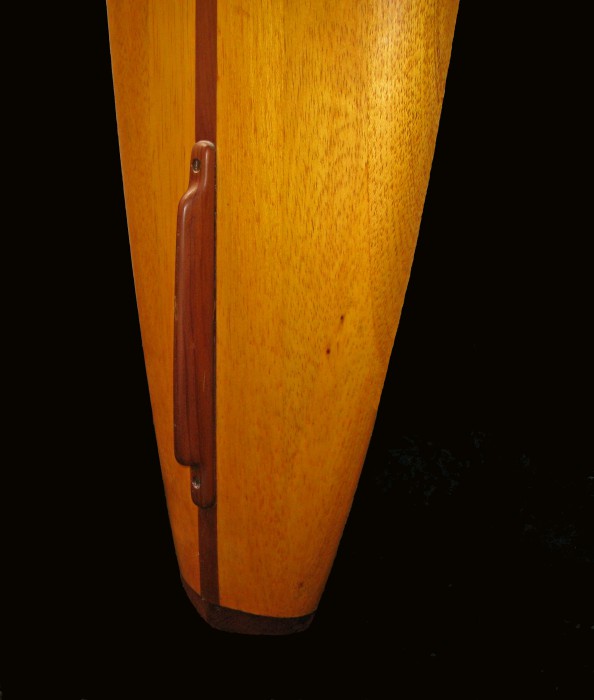
Hot Curl board with early fin (late 1930’s) Surfing Heritage & Culture Center collection photo: Merson
The wood fin gained popularity throughout the 1940’s but there was not much innovation or design change. The fin remained a low profile keel usually 4” to 6” deep and about a foot long. When the fin was added to a hot curl board they out performed Blake’s hollow boards.
The next big design innovation in surfing came in the mid 1940’s with major design contributions by Bob Simmons. Bob started building his own boards in the early 1940’s, solid planks similar to what was popular at the time. He was not a fan of Blakes boards and always referred to them as paddleboards. He studied hydrodynamics and the use of fiberglass and resin, materials that had been used in the war, and by the mid 1940’s he was building boards that eventually would revolutionize surfing. Bob made the first lightweight boards with a foam core sandwiched between plywood veneer, balsa wood rails and wrapped in fiberglass and resin. He designed the first planning hulls and eventually developed rocker, thinner noses and tails, modified hydro foiled rails and concave bottom contour in the tail.
Bob was the first to use dual fins on a surfboard. (There is a picture of Tom Blake standing in front of a dual finned board circa 1943 but nothing is known of the board. Probably a one off experiment.) The tails of his boards were wide and he placed a small fin on each rail at the tail and towed them in 10 degrees. Eye witnesses and test pilots of the day claimed the new boards to be faster than any surfboard in the water. When Simmons died in 1954 in a surfing accident at Windansea no one carried on his work and design concepts. Bob Simmons first twin fins propelled surfing toward the modern age but it would take decades before anyone realized how important his contributions had been.
Californian Joe Quigg started making light-weight balsa and redwood boards around 1947. He, like Simmons, used Malibu as his test track. Joe was one of the first to incorporate rocker in his boards. He shaped the first pintail boards and narrow big wave guns. Quig pulled in the tail and shaped hydrodynamic rails, designed by Simmons, and added rocker to allow his single fins to perform better. He made significant design contributions to the fin by producing the first all fiberglass fin and narrow based long raked-back fins. He is also said to have been the first to put three fins on a surfboard.
Hawaiian George Downing was an early big wave rider and designed some of the first big wave boards that came to be known as guns.
He also had a huge influence on the evolution of the fin by inventing the first fin box for a removable fin in the early 1950’s.
“In the early days I didn’t know quite where the optimum place was to position my fin. I couldn’t keep glassing my fin on, then remove it, and re-glass it…that was a pain in the ass. So I began thinking of some way I could attach my fin to my board without having to glass it on. Knowing about sailboats and the different wood used for sailboat construction, I made the first fin box out of wood with a groove in it so you could take the fin in and out, plus it would enable me to experiment with different size fins. The only problem with my fin box design was I had no way of securing the fin tight to the box. By making the box out of teak wood, made it perfect for ocean use. I used a piece of cardboard to secure the fin tight against the wood before I paddled out. Unless somebody invented the fin box before me, mine is the first one in history. I still have the original balsa wood board I installed it on.” — board circa late 1940s, fin box added in the early 1950s Ocean Magazine
After the death of Bob Simmons the single fin longboard era began. Balsa wood was the material of choice for surfboard shapers from the late 1940’s through the mid 1950’s. The balsa cores were wrapped in fiberglass producing a strong yet fairly lightweight board. They became known as Malibu chip boards.
As surfing gained popularity and the demand for surfboards grew the shapers had a harder time finding enough high quality balsa wood. In the mid 1950’s Hobie Alter and Dave Sweet were independently experimenting with polyurethane foam as a replacement for balsa wood as the core material. After a few years of development and trial and error the foam blank was perfected. It was lighter and much easier to shape than balsa wood and it could be created on demand. By the 1960’s the balsa wood boards had all but disappeared. Everyone wanted the lightweight foam and fiberglass boards. During this time the surfboard fin was made of wood covered with fiberglass or all fiberglass. The fin had grown in depth from the low profile fins of the 1940’s.
The deeper fins added more stability and combined with the new lighter boards, made tighter turns possible. At the time they were referred to as skegs not fins. The most popular fin or skeg of this era was often called the “D” fin. There was not a lot of experimentation with fin design at this time. There were a few exceptions like the “reverse skeg” and a more raked back design referred to as a “speed skeg”.
In 1952 Dale Velzy made the Vee fin which was actually two fins joined together at their base, to help hold the board in the face of the South Bay beach-break waves.
Almost all of the design and creativity of the wood fins were all show and no go. There were sunburst patterns, checker boards and stripes but not much change in the templates.
Through the early to mid 1960’s fiberglass fins gained in popularity and there were a few more styles and templates to choose from. A lot of the design input was directed toward developing a fin that would enhance the nose ridding capabilities of the board. These fins generally had greater depth and larger surface area at the tip.
Dewey Weber had his “hatchet fin”, Greg Noll had a rectangular fin, Carl Ecksrom developed the “bat fin”, Bing came out with the Nuuhiwa Noseridder model with a mild cutaway and raked fin, and there were many others. There were also surfers and shapers looking to improve on the turning capabilities of the mid sixties long boards. The cutaway raked back fins started appearing around 1964 and elevated the boards to a new level of performance.
One of the most popular boards of that era was Mike Hynson’s Red Fin model by Gordon and Smith. In 1965 Hynson introduced the dorsal red fin and then in 1966 he refined his design to a more raked back cutaway version. Other popular cutaway finned boards were Harbour’s Trestles Special, Hanson’s 50/50 model, Hobie’s Phil Edwards model, Morey Pope’s John Peck Penetrator and many others. In 1966 Greg Noll introduced the Micki Dora “da Cat” model with a removable raked back cutaway fin and fin box.
The removable fin dates back to the early 1950’s however they were not commercially available and were only used by a handful of surfers. Tom Morey, with an aerospace engineering and composite background, was an early manufacturer of a removable fin system in the mid 1960’s. Tom Morey’s Skeg Works made the first commercial polypropylene fin boxes and removable interchangeable fin system, TRAF (“fart” spelled backwards). In 1966 Morey improved his design with the Wonder Bolt system. Polypropylene became a popular material to mass-produce fins from during this time although they proved not to be as durable as fiberglass, having issues with sun damage. This was the high performance long board era but surf design was about to change dramatically.
George Greenough was born and raised in the Santa Barbara area. He started surfing on the traditional long boards of the day but did not like anything about them. In 1962 he shaped a short board in the 7 foot range.
The shorter board performed better but he soon discovered that he wanted to ride closer to the water. Later that year George shaped a balsa kneeboard with a scooped out deck and that was the end of his stand up surfing. He made his biggest design contribution to surfing with his development of the flexible high aspect ratio fiberglass foiled fin. High-aspect is an aerospace design term that describes reduced resistance by reducing the fin area while increasing lift. His design was based on the tail fin of a tuna.
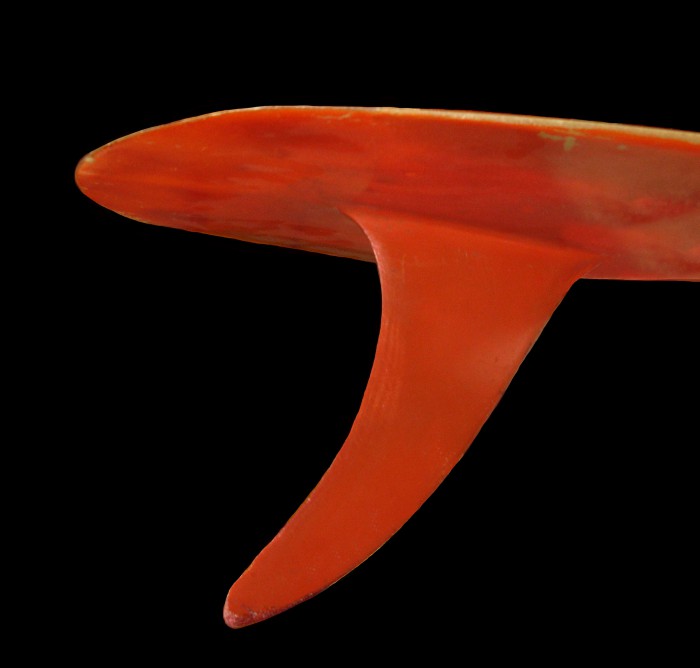
George
Greenough, Velo fiberglass kneeboard with flex fin (mid 1960’s) Surfing
Heritage & Culture Center collection photo: Merson
The performance improvement in speed and turning was so dramatic that it was the basis for all of his future projects. Greenough experimented with flexible fins over the next couple of years. He was so pleased with the results that he started thinking about building a board that flexed like his fin, allowing the board to move as it rode the wave just as a fish moves through the water. In 1965 he made Velo, his first flexible spoon kneeboard driven by an 11” high aspect ratio fin. Greenough went to Australia in 1965 and met up with Bob McTavish and Nat Young. When they saw the way George and Velo accelerated out of turns and surfed the waves in a way they had never seen before, they were inspired to change their own thinking and equipment.
When Greenough explained to them how the fiberglass foiled fin flexed and loaded up torque then exploded out of the turn, they started imagining what it would be like with George’s fins on their surfboards. McTavish, an accomplished shaper, went to work redesigning the surfboard. He shortened the board slightly at first, thinned out the rails and added a “V” bottom and one of George’s fins.
In 1966 McTavish made a board called “Sam” for Nat Young. Nat went to San Diego for the World Contest where he carved circles around the traditional nose riders, won the contest and opened the eyes of the surfing world to the possibilities that lay ahead. This was the beginning of the short board revolution. Once it started the boards just kept getting shorter and shorter.
In 1968 Tom Morey improved on his original interchangeable fin system and with new business partner Karl Pope introduced the Wave Set removable fin system with a variety of interchangeable molded fins. The Wave set system had fins designed by George Greenough, Skip Frye and others.
Greenough offered Stage I, III and IV designs. Frye’s small New-e-Free design focused on sideslipping. The Wave Set system was offered to board manufacturers as a step up option and became very successful throughout the late 1960’s. As boards got shorter the bulky box was modified with a notched male fin base that locked into a molded female box.
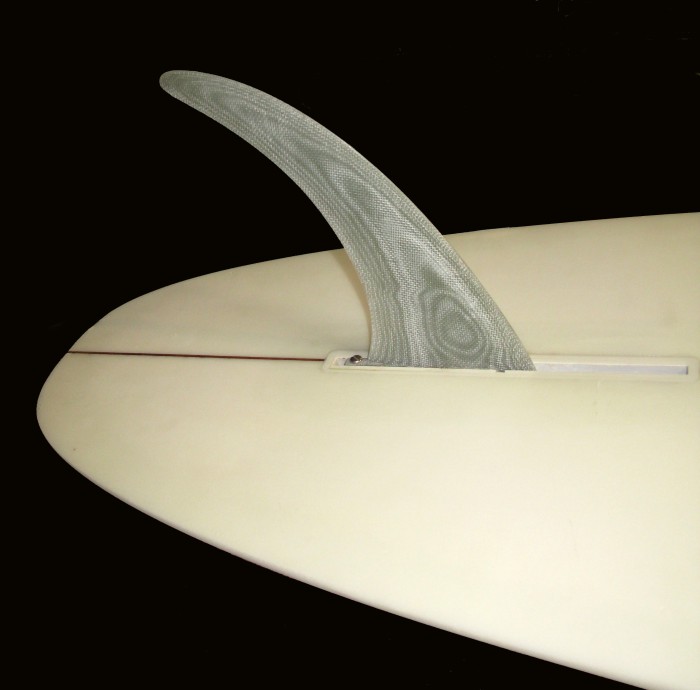
Greg Liddle hull with removable fiberglass flex fin, Surfing Heritage & Culture Center collection photo: Merson
In 1964 Bill Bahne started Fins Unlimited to address the needs of surfers desiring a removable and adjustable fin system. In 1968 Bahne applied for a US Patent for the “Adjustable Surfboard Fin Holder” or the fin box as it came to be known. The patent was granted in February 1971. Bahne’s fin box design was readily accepted as the industry standard. Much of the success was attributed to the fact that the box could accept a wide variety of laminated fiberglass fins.
Most surfers considered fiberglass fins superior to the molded plastic fins. A single fin box and a single fin was the only choice throughout the 1960’s.
The earliest documentation of a twin fin first appeared in 1943 on a board possibly made by Tom Blake. In 1948 Bob Simmons started making twin keel fin boards and they were considered by their riders as the top performing boards of the era. Steve Lis was a knee boarder in La Jolla, California. Lis is credited with the development of the twin fin fish design in 1967 that is still very popular today.
The Lis twin fin design drew a lot of attention in the late 1960’s. At the same time twin fins were being developed in Australia and after the 1970 World Contest in Victoria several U.S. board builders jumped on the twin fin band wagon. One of the first was Bing with a Mike Eaton designed wide tailed twin fin for World Champion Rolf Aurness. Surfer David Nuuihwa experimented with shorter designs, Terry Martin at Hobie Surfboards shaped boards for Corkey Carroll and others. By 1971 most board manufacturers offered a twin fin in their line up. Some worked and some didn’t. The problem was in figuring out the fin placement, toe in, cant and template. They didn’t work well in larger more powerful waves and after a couple of years most lost interest in the design.
Steve Lis’s fish design caught the attention of stand up surfers in southern California.
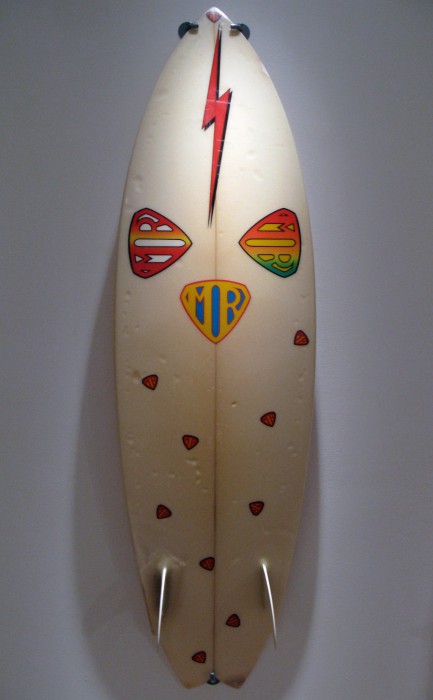
Mark Richards MR Twin Fin (late 1970’s) Surf Craft exhibit Mingei International Museum photo: Merson
A longer narrower board was developed in 1974 with a swallow tail and became known as the “Rocket Fish”. Carl Hayward, Clyde Beatty and Steve Brom were early rocket fish pilots and shapers. In 1976 Australian Mark Richards, influenced by a small twin fin designed by Hawaiian Reno Abellira, started working with shapers Dick Brewer and Ben Aipa on a new twin fin swallow tail design. After much refinement the new design worked well in larger surf as well as small surf. Richards rode the new MR twin to several contest wins and the World Title in 1979.
Gordon and Smith Surfboards made Mark Richard models under license in the U.S. and were available with Star Systems fin boxes. Variations of the new twin fin design soon became available from all manufacturers and were the popular choice from 1979 thru 1981.
While variations on the fish design gained popularity throughout the 1970’s, in out of the way Oxnard California, two teenage brothers, Duncan and Malcom Campbell were being very creative. The Campbell brothers were riding short 5’6” to 5’8”, wide tailed Australian influenced single fins. The brothers felt that the short boards did not provide the drive or speed needed when the waves were larger and more powerful. It was their father who first came up with the idea of three fins. After doing some research on boats and hydrodynamics they settled on a stretched out triangular shaped keel about 10” long. The keels were mounted just off the rails ahead of the center fin. For the next couple of years they refined the design. The bottoms started off flat at first and then evolved into the single to double concave tails that the Bonzer became known for. The boards worked really well but no one outside of Oxnard new about them. The Campell brothers sent letters and pictures to several board manufacturers and magazines.
Bing responded in a week and set up a meeting. After discussing the design merits and watching some film footage, Bing and lead shaper Mike Eaton acknowledged that the boards worked. In 1973 Bing started producing Bonzers and kicked off an ad campaign. The publicity helped to sell some boards but the design never became mainstream. Bing sold his company to Gordon and Smith in 1974 and the new powers to be never got behind the Bonzer. The Campbell brothers ended the relationship and went back to making their own boards. Several pro surfers found success riding Bonzers including Terry Fitzgerald, Peter Townend and Ian Cairns. The Campbell brothers kept refining the design but the boards did not have much of a following probably because for shapers at that time the concaves were difficult to get right and the keel side fins had to be custom made.
In 1980 Australian pro surfer and shaper Simon Anderson was getting frustrated with contest surfing in small waves. He was going back and forth between a twin fin in small surf and a single fin in larger surf. He was struggling to find a board that worked well particularly in 2’-4’ surf. Simon saw a friend, Frank Williams, ridding a twin fin with a small trailing center fin which made the twin fin design more stable. It was at that moment that Simon decided to make a three finned board with a full sized fin on the tail for stability.
The board worked great and in 1981 he won the Bell’s Beach Classic, Coke Surfabout and the Pipeline Masters on his 3 fin thruster. Within a couple of years the 3 fin thruster became mainstream and dominated the surfboard market. Today, over 30 years later it is still the most popular board design for pros as well as recreational surfers. What is amazing is that in 30 years Simon has only moved the fin placement an 1/8”. The original Thruster design was pretty much right on target.
In 1983 the Campbell brothers built the first 5 fin Bonzer. Based on the same principals as their earlier 3 fin design, the 5 fin broke up the side fin area differently. The improvement in performance was dramatic especially in larger more powerful surf. The 5 fin design won over many new converts to the Bonzer camp and the popularity in this revolutionary design continues to grow to this day.
In the early 1980’s pro surfer and shaper Glenn Winton was one of the first to develop the 4 fin “quad” design. Winton found the center fin on the thruster to be restrictive and made the board slow in small waves. He replaced the center fin with a pair of small twin fins at the back of the board. Winton was successful with a quad on the pro tour and there was a great deal of interest in his quad design.
Another early quad surfer and designer was Rusty Preisendorfer. Rusty believed the quads were faster, looser, rode the barrel higher and tighter, accelerated better on cutbacks and drew new and different lines than the thruster. Australian Bruce Mckee has been designing quads for decades. He made Kelly Slaters 2012 Trestles contest winning board as well as boards for Tom Curren, Tom Carroll, Mick Fanning and Joel Parkinson. Mckee makes quad shortboards, longboards, guns and tow in boards. Mckee calls his boards “Quattro” and is quick to share his knowledge about the superior performance aspects of his design over the thruster. Even though the thruster has been the most popular board for the past 30 years there are many creative designers offering exciting alternatives.
In 1990 one of the biggest innovations in modern surfboard design was the invention of the plug changeable fin system first pioneered by FCS (fin control system) and patented in 1995. Most shortboards had glassed on fins which left little room for fin experimentation other than a little sanding or re-shaping of the template and foil.
The plug systems allowed for easy fin replacement and opened new doors for innovation and board tuning. It didn’t take long before there were many manufacturers making changeable fin systems such as Futures, Lokbox, O’Fish’L, Probox, Red-X and more.
http://www.thefinbox.com/history/history-of-the-fin/
Suscribirse a:
Comentarios (Atom)



















